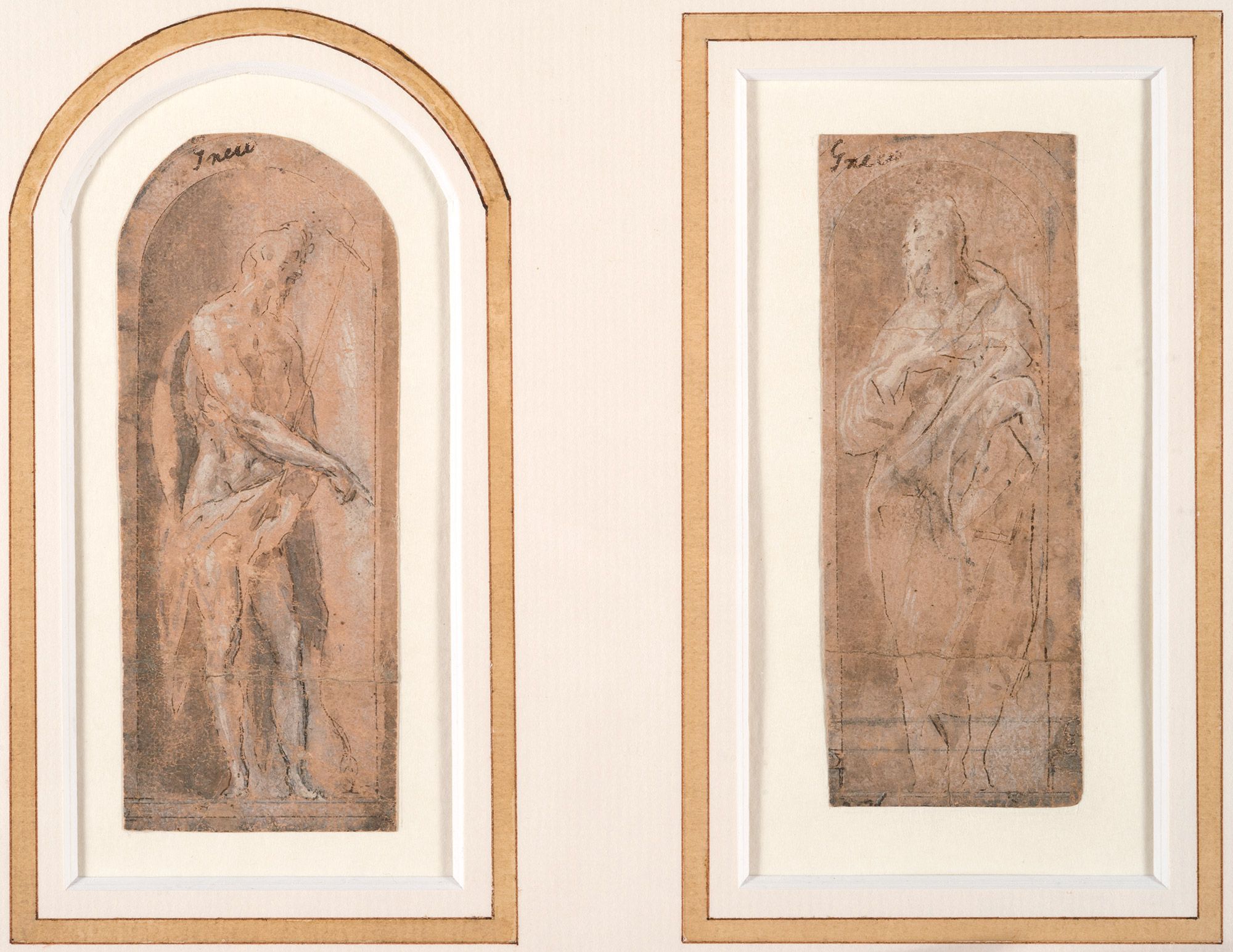FJK 044
El Greco (Domenikos Theotokopoulos) (Greek, Iráklion (Candia) 1540/41–1614 Toledo)
Saint John the Baptist (i)
Saint John the Evangelist (ii)
1577
5 23/64 × 2 11/64 in. (136 × 55 mm, i) / 5 23/64 × 1 31/32 in. (136 × 50 mm, ii)
Medium
Pen brown ink, brown and grey wash over traces of charcoal with white highlights on paper
Anonymous inscriptions in ink on both drawings, most likely from the 17th century: Greco
Origin
Sir William Stirling-Maxwell Collection (acquired before 1877)
Lt.-Col. William Stirling of Keir Collection (by descent)
His sale, Sotheby’s, London, October 21, 1963, no. 12
Private Collection, Great Britain
Sale, Bonhams, London, December 9, 2002, no. 101
Jan Krugier Collection, Monaco, JK 6104
Jan Krugier Foundation
Bibliography
HARRIS Enriqueta, “Spanish Painting from Morales to Goya in the National Gallery of Scotland,” in The Burlington Magazine, 93, 1951, pp. 313-314.
WETHEY Harold E., El Greco and His School, Princeton University Press, 1962, vol. 2, p. 152.
ANGULO Diego, PÈREZ SÀNCHEZ Alfonso E., A Corpus of Spanish Drawings. Spanish Drawings 1400-1600, Boston: Harvey Miller, London & New York Graphic Society, 1975, vol. 1, nos. 157-158, pl. XLVI.
HARRIS-FRANKFORT Enriqueta, “El Greco's "Fortuna Critica" in Britain,” in El Greco of Crete. Proceedings of the International Symposium-Iraklion, Crete, 1995, p. 486, fig. 7a-7b.
Exhibitions
Edinburgh, The National Gallery of Scotland, Spanish Painting from Morales to Goya in the National Gallery of Scotland, 1951.
London, Royal Academy of Arts, Drawings by Old Masters, 1953, pp. 110-111, no. 491.
London, The National Gallery, El Greco, 2004, pp. 118-119, nos. 18 (i)-19 (ii), color ill.
Munich, Kunsthalle der Hypo-Kulturstiftung, Das Ewige Auge - Von Rembrandt bis Picasso. Meisterwerke aus der Sammlung Jan Krugier und Marie-Anne Krugier-Poniatowski, 2007, p. 92, no. 38, color ill. p. 93.
Toledo, Museo de Santa Cruz, El Greco : arte y oficio / El Greco : Painter and Master, (09.09-09.12.2014), color ill.
Notes
The two drawings probably once formed part of a much larger composition depicting the altarpiece commissioned by Diego de Castilla from El Greco for Santo Domingo el Antiguo. In its original state, the complete drawing would have served as a "contract piece" which El Greco would have presented and discussed with his patron. That strict supervision was imposed on El Greco's artistic ideas is reflected in the memorandum attached to the original contract for Santo Domingo, to which the drawing was probably attached. It stressed that Diego de Castilla had the sole and complete authority to accept, reject or order alterations to the finished pictures. “If any of these paintings are not satisfactory in part or in whole, the said Dominico is obliged to correct them, or remake them, so that the work is perfect and acceptable to Don Diego, canon, whose opinion will be submitted to said Dominico... And whatever is said must be done, without any appeal except to that of the wishes of said dean.”
Comparisons between these two drawings and the paintings of Saint John the Baptist and Saint John the Evangelist, both still in situ to the left and right of the central large painting of The Assumption reveal much about El Greco's thinking and working methods. Initially, El Greco's idea was to set the figures of Saint John the Baptist and Saint John the Evangelist in niches forming part of the altarpiece that he had designated, recalling those he would have seen in Venice by Jacopo Sansovino. In the drawings, he has carefully defined the architectural lines with the aid of a ruler and compass. Using black and brown washes and white chalk, he suggests a space behind the figures into which their shadows are cast. Working in grisaille, El Greco seems to have been using the example of sculpture in order to understand the fall of light and the volume of the figures and to define the space they were to occupy. In the final paintings, the niches were discarded and instead both figures are shown standing on a clump of earth with blue sky and clouds behind them probably to create a more direct visual connection with the sky in The Assumption.
This exampe shows how El Greco used drawings to try out poses and test the dynamics of his subjects so as to achieve visual harmony with other elements of a much larger complete composition. The subjects of his paintings needed to relate visually to each other so as to render the iconography of the altarpiece comprehensible to the viewer. Saint John the Baptist, for example, is shown pointing down to the tabernacle or crucifix on the altar placed before the centre of the polyptych, a detail which El Greco kept in the final painting. Instead of being accompanied by the Lamb that symbolises Christ in his sacrificial rôle, a usual, the Baptist is shown here referring indirectly to the Lamb by pointing to the altar where his sacrifice is re-enacted during Mass.
In both the drawings and the painting Saint John the Baptist is shown standing threee-quarters to the picture plane, his face turned in profil perdu, his body strongly illuminated on the right side, the left cast in deep shadow. In the drawing, this chiaroscuro modelling of form is realised by a deft use of brush and wash and delicate touches of white heightening. In representing his figures in this way, El Greco was probably taking into account the natural lighting of the altarpiece from a window on the left. The whole conception looks back to examples El Greco had seen in Italy. The elongation and boniness of the Baptist's body in the drawing recall figures in drawings by Parmigianino, which El Greco may have seen when passing through Parma or in the collection of a fellow Cretan. Michael Damaskinos, who owned a collection of drawings by Parmigianino which he sold on to the sculptor Alessandro Vittoria. However, it is above all Titian's influence in the application of colour and light that is felt in El Greco's painting. Indeed, El Greco may have known Titian's treatment of the same saint in a painting sent from Venice to Philip II in 1574 and known to have been in the Escorial by 1577.
Unlike Saint John the Baptist, the figure of Saint John the Evangelist was considerably altered between the drawing and the painting. The drawing shows the Evangelist symmetrically balancing the Baptist at a similar three-quarters angle to the picture plane. However, rather than looking down, his head is thrown slightly back as he looks heavenwards. El Greco may have wanted to show him looking up towards the ascent of the Virgin but finally, perhaps after consulting Diego de Castilla, he abandoned this ecstatic posture for a more contemplative stance. A second drawing now in the Biblioteca Nacional, Madrid, shows the Evangelist standing parallel to the picture plane and directly facing the spectator, his head bent forward in rapt contemplation of the open book in his left hand. El Greco's initial idea for the Evangelist's pose was not wasted, however, as he adapted it in his representation of one of the Apostles witnessing the assumption of the Virgin (first from the right).
Xavier Bray, exh. cat. London, National Gallery, 2004. pp. 118-119
Request for information/loan
The Jan Krugier Foundation is devoted to increasing the impact of the collection of drawings through regular loans to major exhibitions. Loan applications should include a complete presentation of the project.

